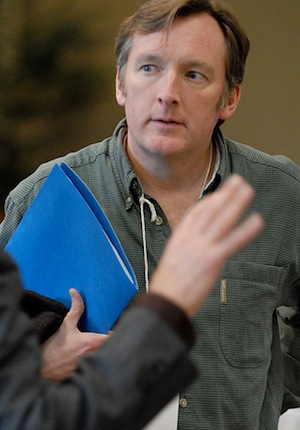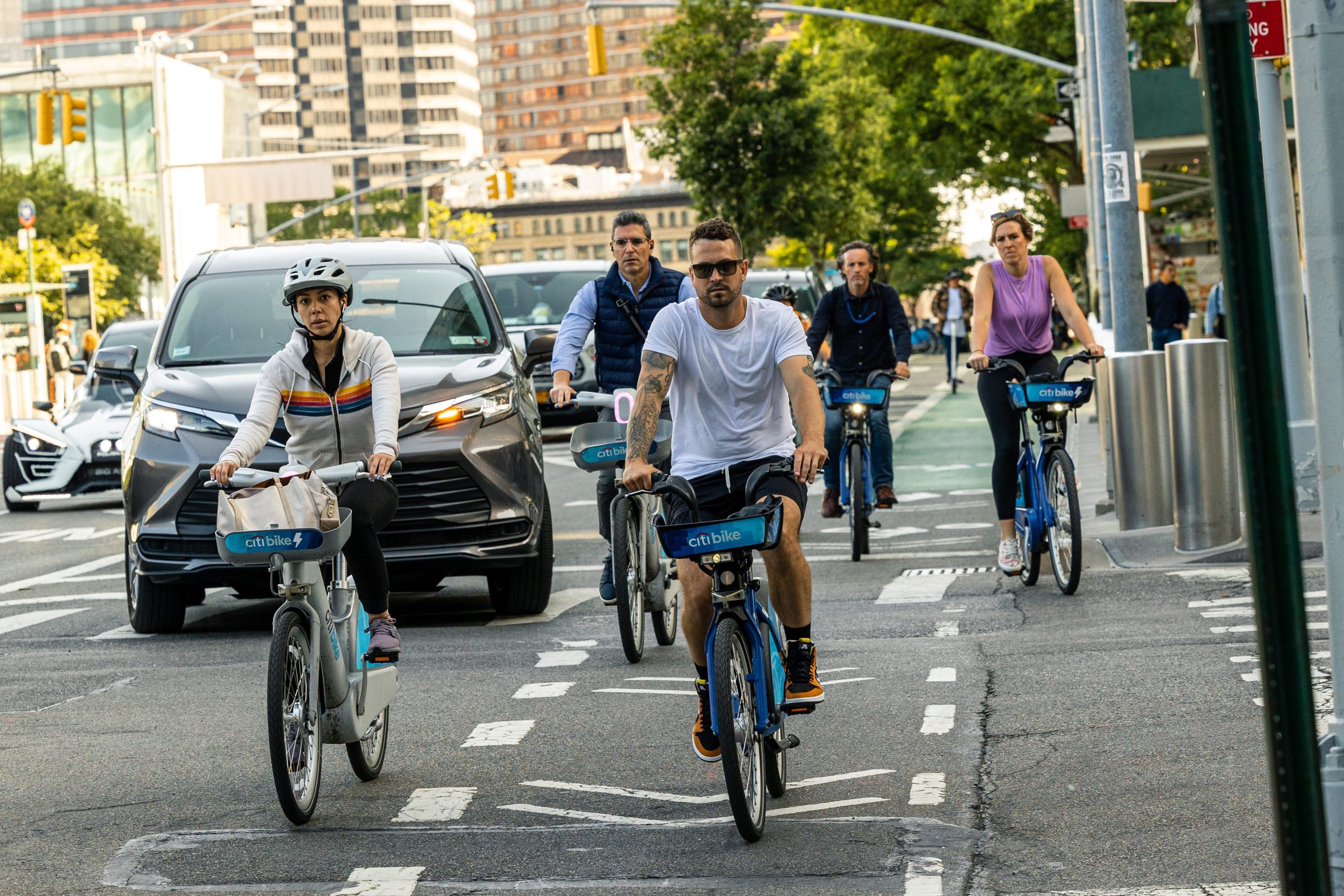
Back in August, Mayor Bloomberg appointed David Bragdon to succeed Rohit Aggarwala as head of the city's Office of Long-Term Planning and Sustainability. At the time, Bragdon was the elected leader of Portland's regional government, Metro, and an influential decision maker in that region's famously progressive planning. Sustainable transportation advocates on both coasts said New York was lucky to get him.
Tops on Bragdon's agenda these days is next year's update of PlaNYC. The first version of PlaNYC, released in 2007, included bold transportation and planning initiatives to reduce traffic, fund transit, and give priority to bikes, buses, and pedestrians on our streets. On Earth Day 2011, a new version of the city's sustainability plan is set to be released, and Bragdon's staff have been busy holding public meetings around the city gathering ideas for the update.
We sat down with Bragdon to learn more about what to expect from PlaNYC 2.0, what lessons New York can draw from Portland, and what still has to be done to follow through on un-finished business from the first version of PlaNYC. Below is an edited transcript of our conversation.
Noah Kazis: The first thing that I wanted to ask was what you’ve been hearing from the community conversations. I was at the one in the Bronx, but the others?
David Bragdon: The one in the Bronx was really oriented towards younger people and that’s who showed up, that was great to see. There’s a lot on natural area restoration in the Bronx. The equity of access to nature, that was sort of the dominant theme at that particular one, which - I’ve a strong affinity for that personally.
Each of them has been a little bit different, and it partly depends on who shows up. I would say the one in lower Manhattan, we heard more there about renewable energy, and I think there was a strong theme of local food at the one in Manhattan.
NK: Any patterns emerging?
DB: I think also in the replies over the web, there have been a few that have come up strongly. More recycling opportunities has been a strong theme in all those different media, transportation choices obviously has been a big one. I think food and farmers markets have also been strong across the board.
NK: Early this year we wrote a story about how Portland Metro was working with the private sector, both developers and banks, to get them comfortable with pushing transit-oriented development a step further. Does that need to happen in New York?
I’ve personally already, just in the time I’ve been here, had developers tell me the current codes required them to build more parking than the market would require.
DB: I think there’s actually a very strong constituency within the architecture and engineering industries here, there’s a very strong chapter of the US Green Building Council here. New York’s always been a center for architectural excellence, but this niche of it probably doesn’t get as much public notice as it deserves given the talent that is here, and the buildings that have been built here. You know, 1 Bryant Square, the new Times Building, there’s a wide variety of examples.
NK: One of the specific things those developers in Portland needed help with was the idea of having less parking for their project. In the last few years, we’ve seen a lot of projects go up here in New York that have significantly higher amounts of parking than the older building stock. Is that something that’s coming from the private sector?
DB: Yes, that’s something to look at in PlaNYC. I’ve personally already, just in the time I’ve been here, had developers tell me in certain parts of the city the current codes required them to build more parking than the market would require. And certainly that’s - something needs to be updated. There you have a private sector person saying that the city codes reflect a parking demand situation of the past.
NK: That’s the off-street requirements. Are you also looking at on-street?
DB: Yes. And there are three pilots going on with regard to some of the on-street as well, so we’ll be trying to learn from those.
NK: Also on the development side, in the housing section of PlaNYC, the first goal is to encourage transit-oriented development, and the second goal is to encourage waterfront development, which sometimes have been in conflict.
DB: Some parts of the waterfront, particularly the previously industrial parts, don’t have good subway service.
When I was a kid I was on supposedly the last ferry from Manhattan to Hoboken. And look at it today. Ferries are back on the Hudson River.
NK: How do you square that circle?
DB: Soon some of them will have ferry service, that will be part of the solution. I think there’ll be some announcements about that.
NK: Yeah, the East River pilot just got announced.
DB: I think part of it, and it’s been experimented with before, part of it becomes a matter of ongoing funding for the operations on the ferry service.
NK:I know that subsidies could be $20 a ride or so, which is out of line with other transit costs.
DB: Right. The per-seat cost is quite high. Part of that will vary depending on how much directionality there is, do you have long deadhead moves [empty return trips], and is it purely a peak hour service. Part of it relates to how much of it is fixed cost. But part of it is also that they’re just expensive to operate on the per-seat basis.
But it’s interesting to see the revival of ferry service on an interstate basis over the last, what, 15, 20 years? When I was a kid I was on what was supposedly the last ferry from Manhattan to Hoboken, which would have been 1965, ’66, it was the old Erie Lackawanna, and when that docked everybody said “Okay, that’s the end of ferry service on the Hudson River.” And look at it today. Ferries are back on the Hudson River.
NK: Do you know why the Hudson River ferries have been so much more successful than the East River ferries so far?
DB: That’s worth looking at.
NK: One theory I have heard is just that there are free bridges over one side, and you have to pay to get over the other.
DB: That makes sense, yeah. That makes a lot of sense
NK: Also they just build up to the river, right? You look at the Hudson and it’s a wall of buildings, that’s not true on the East River.
DB: Yeah, I think in spatial terms that’s probably a better explanation, in that there are big generators on both sides of the river. Think about the Hoboken terminal, all the Erie Lackawanna trains that run into there that are delivering thousands of people who then have to walk 50 feet to get on a ferry, and then when they get off the ferry on the Manhattan side they can walk three or four blocks to their desk. All that development on the Jersey City side is also walking distance from the water. So that’s a different spatial layout than a lot of the East River.
I think that’s part of the issue with the ferries on the East River. How does a person get from wherever he or she starts the trip, which is probably some distance from the waterfront, and then once they get to Manhattan, say they dock on the East River at 34th Street, they’re less likely to work within a few blocks of there than if you’re landing at Battery Park City.
NK: True.
DB: Okay, so we just solved the mystery of why the Hudson River has more ferries. We should charge for this.
NK: That also leads us to the question of 34th Street Transitway.
DB: Yeah. The slowest bus in the world, need to speed it up.
NK: This year I think it was 42nd Street that won.
DB: It’s an ignominious competition each year.
NK: There’s been a lot of pushback on the East Side in particular against this project, how’s the city working to build support for it?
DB: It’s a matter of trying to work with the property owners and address the concerns. There are concerns about how to get deliveries to businesses, and we’ll try to accommodate those. I think the solutions probably look different block by block. DOT has been continuing to do outreach in conjunction with the MTA on those. Because there’s an interest in expediting bus service there, which is ultimately very good for the community. But trying to mitigate some of these immediate smaller grained effects on the adjoining properties on this route is important.
Stay tuned tomorrow for the second half of our interview, where Bragdon discusses transportation funding and the future of the Sheridan Expressway.





